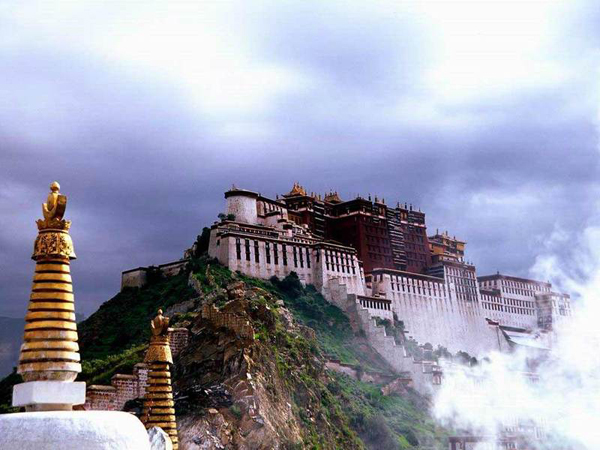Potala Palace
The symbol of Tibet, the Potala Palace is located in the center of Tibet Lhasa City. The palace is situated on top of Marpo Ri (Red Mountain) and it was named after Potalaka Mountain, the mytholical abode of Avalokitesvara, a Bodhisattva who embodies the compassion of all Buddhas. It was the main residence of the Dalai Lamas beginning with the Fifth Dalai Lama.
The palace was built on the site of an earlier palace built by Songtsan Gampo and the two chapels on its northwest corner are parts of the original building and a cavern was used as Songtsan Gampo’s meditation cave. Construction on the Potala Palace began in 1645 by the Fifth Dalai Lama. It took 3 years to complete the palace’s exterior and the interior took 45 years. In 1649, the Dalai Lama moved in and construction was not finished until after his death in 1694. During the Cultural Revolution, almost all of the 100,000 volumes of sutras, works of art, and documents were destroyed.
The Potala Palace has huge inward-sloping walls which are 5 meters thick as the foundation. It has the appearance of a huge mountaintop fortress. The palace is visibly split into two sections, the red and white palaces. They are named for the colors of their paints. The red palace is painted red to represent power. It has a complicated layout of halls, chapels, and shrines of the past Dalai lamas. The interior of the section is covered with rich painting and carvings. The central hall of the red section is the Great West Hall. It has four chapels which and is noted for its murals which depict the Fifth Dalai Lama’s life. The Saint’s Chapel is the holiest shrine in the entire palace. The white palace is painted white to symbolize peace. It is the upper section of the palace and contained offices, seminary, printing house, and the Dalai Lama’s residence. The fourth floor is home to the Great East Hall where important religious and political events were held. The fifth and sixth floors were the living quarters and offices of the regents and the seventh floor was the Dalai Lama’s living quarters. There is a courtyard which is yellow that separates the white and red sections. It contains the gold stupas, the tombs of eight Dalai Lamas, and is devoted to religious study and prayer. The yellow building in the courtyard houses giant banners which were hung on the Potala Palace during the New Year Festival.


.jpg)












